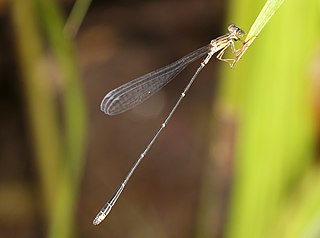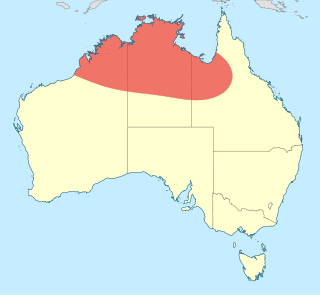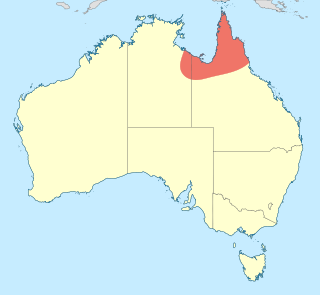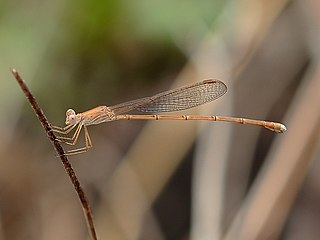
Rhadinosticta is a genus of damselfly in the family Isostictidae, endemic to eastern Australia. Species of Rhadinosticta are slender, medium-sized damselflies, with a dull colouring.

Lestoidea is a genus of damselflies in the family Lestoideidae, commonly known as bluestreaks. Its species are endemic to north-east Queensland, Australia, where they inhabit rainforest streams.

Austroagrion is a genus of damselflies belonging to the family Coenagrionidae. Species of Austroagrion are small damselflies; males are black with blue or green markings while females are paler. Austroagrion occurs in Papua New Guinea, New Caledonia and Australia.

Austrocnemis is a genus of damselflies belonging to the family Coenagrionidae. Species of Austrocnemis are tiny, bronze-black damselflies with long legs. They occur in New Guinea and Australia.

Caliagrion is a monotypic genus of damselflies belonging to the family Coenagrionidae. The single species of this genus, Caliagrion billinghursti, is commonly known as a large riverdamsel, and is endemic to south-eastern Australia, where it inhabits slow-flowing rivers and ponds.

Austrosticta is a genus of damselflies belonging to the family Isostictidae. It is endemic to northern Australia. Species of Austrosticta are medium-sized damselflies, dull grey-brown in colour.

Oristicta filicicola is a species of damselfly belonging to the family Isostictidae. Until 2017 it was the only species of the genus Oristicta. Commonly known as a slender wiretail, it is a slender and dull-coloured damselfly of medium-size. It is endemic to north-eastern Australia, where it inhabits streams in rainforests.

Neosticta is a genus of damselflies belonging to the family Isostictidae. It is endemic to eastern Australia. Species of Neosticta are medium-sized damselflies, with a dull brown or black colouring and pale markings.

Griseargiolestes is a genus of damselflies in the family Megapodagrionidae. They are medium-sized, black and green metallic damselflies with pale markings, endemic to eastern Australia.

Archibasis mimetes is a species of damselfly in the family Coenagrionidae, commonly known as a blue-banded longtail. It is a medium-sized damselfly; the male is bright blue and black. It has been recorded from New Guinea and northern Australia, where it inhabits streams.

Austrosticta fieldi is a species of damselfly in the family Isostictidae, commonly known as a northern pondsitter. It has been recorded from Northern Territory, Australia, where it inhabits streams.

Austrosticta frater is a species of damselfly in the family Isostictidae, commonly known as a eastern pondsitter. It has been recorded only from northern Queensland, Australia, where it inhabits ponds and possibly streams.

Neosticta canescens is a species of damselfly in the family Isostictidae, commonly known as a southern pinfly. It can be found in eastern Australia, where it inhabits streams.

Austrolestes insularis is an Australian species of damselfly in the family Lestidae, commonly known as a northern ringtail. It is widespread across northern Australia, where it inhabits streams, pools, and ponds.

Indolestes alleni is a species of damselfly in the family Lestidae, commonly known as a small reedling. It is found across northern Australia where it inhabits lagoons, ponds and swamps.

Austroargiolestes alpinus is a species of Australian damselfly in the family Megapodagrionidae, commonly known as a New England flatwing. It is endemic to north-eastern New South Wales, where it inhabits streams and bogs.

Austroargiolestes chrysoides is a species of Australian damselfly in the family Megapodagrionidae, commonly known as a golden flatwing. It is endemic to south-eastern Queensland, where it inhabits streams in rainforest.

Griseargiolestes intermedius is a species of Australian damselfly in the family Megapodagrionidae, commonly known as an alpine flatwing. It is endemic to alpine areas of Victoria and New South Wales, where it inhabits bogs and seepages.

Episynlestes albicauda is a species of Australian damselfly in the family Synlestidae, commonly known as a southern whitetip. It is endemic to south-eastern Queensland and north-eastern New South Wales, where it inhabits streams and pools in rainforests.

Oristicta rosendaleorum is a species of damselfly belonging to the family Isostictidae. It was described by Theischinger and Burwell in 2017. Until 2017 Oristicta filicicola was the only species of the genus Oristicta which has now been widened to include Oristicta rosendaleorum. The common name suggested for the new species is elegant wiretail.





















